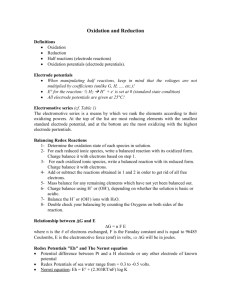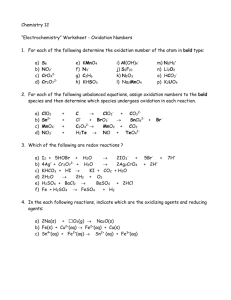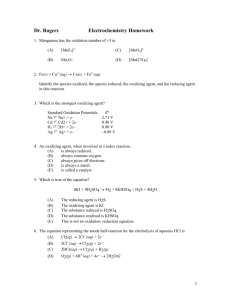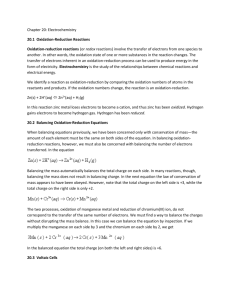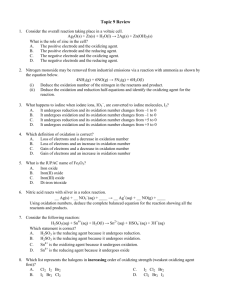Lesson 17.2 cell potential
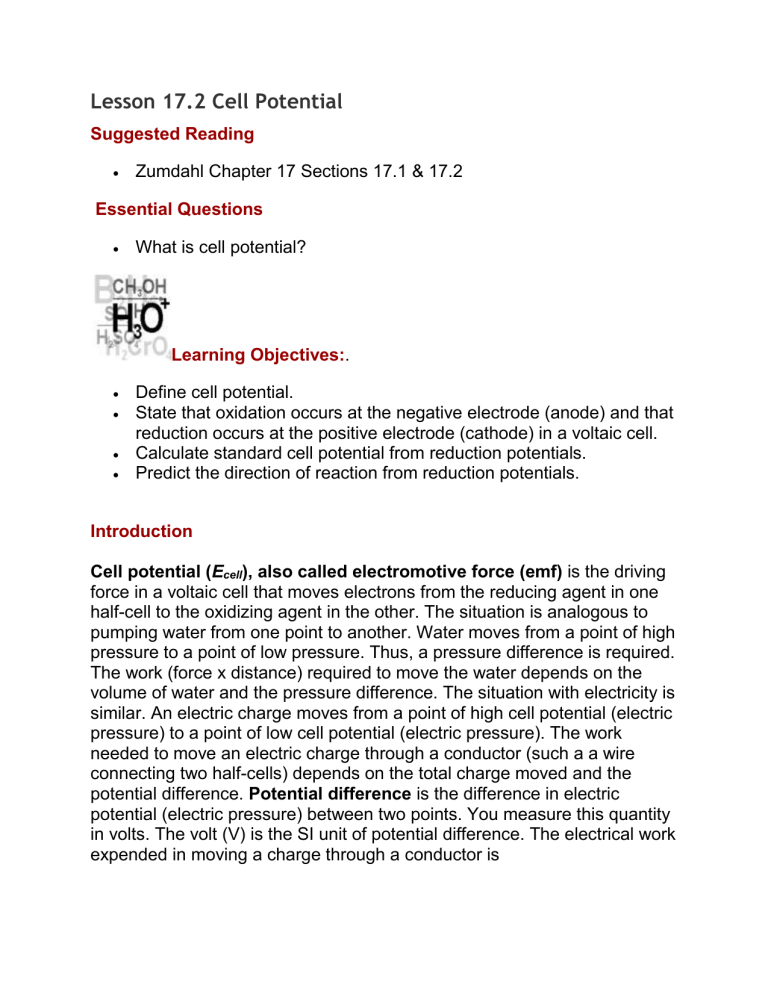
Lesson 17.2 Cell Potential
Suggested Reading
Zumdahl Chapter 17 Sections 17.1 & 17.2
Essential Questions
What is cell potential?
Learning Objectives: .
Define cell potential.
State that oxidation occurs at the negative electrode (anode) and that reduction occurs at the positive electrode (cathode) in a voltaic cell.
Calculate standard cell potential from reduction potentials.
Predict the direction of reaction from reduction potentials.
Introduction
Cell potential (E cell
), also called electromotive force (emf) is the driving force in a voltaic cell that moves electrons from the reducing agent in one half-cell to the oxidizing agent in the other. The situation is analogous to pumping water from one point to another. Water moves from a point of high pressure to a point of low pressure. Thus, a pressure difference is required.
The work (force x distance) required to move the water depends on the volume of water and the pressure difference. The situation with electricity is similar. An electric charge moves from a point of high cell potential (electric pressure) to a point of low cell potential (electric pressure). The work needed to move an electric charge through a conductor (such a a wire connecting two half-cells) depends on the total charge moved and the potential difference. Potential difference is the difference in electric potential (electric pressure) between two points. You measure this quantity in volts. The volt (V) is the SI unit of potential difference. The electrical work expended in moving a charge through a conductor is
Electrical work = charge x potential difference
The corresponding SI units for the terms in this equation are
Joules = coulombs x volts
Thus, cell potential tells us something about a cell's ability to do work, or power things such as your calculator.
Measuring Cell Potential
Quantitatively, the cell potential (emf) is the maximum potential difference between the electrodes of a voltaic cell. It can be measured by an electronic digital voltmeter, which detects the current.
You can also use a voltmeter to determine which electrode is the anode and which is the cathode. The digital voltmeter gives the reading with a sign attached, from which you can deduce the sign, or polarity, of each electrode. The anode has the negative polarity and the cathode has the positive polarity. The maximum electrical work that can be done by a voltaic cell for molar amounts of reactants (according to the cell equation) is w max
= -nFE cell where n is the number of electrons transferred in the overall cell equation, E cell is the cell potential, and F is a constant known as the Faraday constant. The
Faraday constant is the magnitude of charge on one mole of electrons; it equals 96,500 coulombs.
Example: Calculating the Quantity of Work from a Given Amount of Cell Reactant
The emf of a particular voltaic cell with the reaction
Hg
2
2+ (aq) + H
2
(g) ⇌ 2Hg(l) + 2H + (aq) is 0.650 V. Calculate the maximum electrical work of this cell when 0.500 g of H2 is consumed.
Solution:
The maximum work equals nFE
cell . To get n, you write the half reactions, multiplying each, if necessary, by a factor to equalize the number of electrons. Then, n equals the number of electrons in either half reaction.
The half-reactions are
Hg
2
2+ (aq) + 2e ⇌ 2Hg(l)
H
2
(g) ⇌ 2H + (aq) + 2e -
In this case the number of electrons is in balance, and n = 2.
All of the other quantities in w max
= -nFE cell
are known so now we can substitute and solve.
w max
= -2(96,500 C)(0.650 V) = -1.24 x 10^5 V ∙ C = -1.23x10^5 J
This quantity represents w per mole due to the stoichiometry of the cell reaction. Therefore, the maximum work for
5.00 g H 2 is
The quantity -1.23x10
5 J/mol H
2
is a conversion factor that comes from the balanced chemical equation. In the equation, 1 mol of H
2
reacts, and the maximum work produced is -1.23x10
5 J.
Electrode Potentials
A cell emf is a measure of the driving force of the cell reaction. This reaction occurs in the cell as separate half-reactions: an oxidation halfreaction and a reduction half-reaction. The general forms of the half-
reactions are reduced species → oxidized species + n e (oxidation/anode, voltaic cell) oxidized species + n e → reduced species (reduction/cathode, voltaic cell)
The cell emf is composed of a contribution from the anode (whose value depends on the ability of the oxidation half-reaction to lose electrons) and a contribution from the cathode (whose value depends on the ability of the reduction half-reaction to gain electrons). We call these contributions the oxidation potential and the reduction potential, respectively. Then,
E cell
= oxidation potential + reduction potential
A reduction potential is a measure of the tendency for the oxidized species to gain electrons in the reduction half-reaction (in other words, a measure of the ability of the species to act as an oxidizing agent). Chemists have constructed tables of reduction potentials, which gives us a list of strengths of oxidizing agents as well as a way to calculate cell emfs. Below is an example of such a table.
When reduction potentials are determined under standard conditions of 1
M, 1 atm and 25 ∘ C, they are called standard electrode potentials and the
superscript degree sign is used. Notice that the standard reduction potential for H
2
is 0. This value was arbitrarily assigned to H
2
and all other reduction potentials are determined relative to H
2
. Notice the positive and negative values above and below H
2
. The positive values above H
2
reflect half-reactions with greater reduction potentials than H
2
. Similarly, the negative values are given to half-reactions with lesser reduction potentials than H
2
.
Tables such as the one above are always written for the reduction half reaction. However, as the equation
E ∘ cell
= oxidation potential + reduction potential suggests, we need both the oxidation and the reduction potential in order to calculate cell potential (emf). The oxidation potential is also found from the reduction potential table. What we do is find the reverse of the oxidation half-reaction on the reduction potential table and then change the sign on the value given. The webpage linked below illustrates this.
Calculating Standard Cell Potentials
Read the following web page about calculating cell potentials at standard and non standard conditions. BUT ONLY READ THE FIRST TOPIC
ENTITLED DETERMINING STANDARD STATE CELL POTENTIALS. http://www.chem.purdue.edu/gchelp/howtosolveit/Electrochem/Electrochem ical_Cell_Potentials.htm#Standard
Predicting the Direction of Reaction from Electrode Potentials
You can use a table of electrode potentials to predict the direction of spontaneity of an oxidation-reduction reaction. When an oxidationreduction reaction is spontaneous as written, the stronger oxidizing agent will be on the left. Thus, a spontaneous reaction proceeds from the stronger to the weaker oxidizing agent. Lets look at an example.
Example: Determining the Direction of Spontaneity from Electrode
Potential
Consider the reaction
Zn 2+ (aq) + 2Fe 2+ (aq) → Zn(s) + 2Fe 3+ (aq)
Does the reaction go spontaneously in the direction indicated, under standard conditions?
Solution:
Find the oxidizing agents in the equation; one is on the left side and the other is on the right side (remember the oxidizing agents are themselves reduced). Locate these oxidizing agents in a table of electrode potentials.
The stronger oxidizing agent is the one with the more positive standard electrode potential. In this reaction the oxidizing agent on the left is Zn 2+ and Fe 3+ is the oxidizing agent on the right. The corresponding standard electrode potentials are
Zn 2+ (aq) + 2e → Zn(s); E ∘ = -0.76 V
Fe 3+ (aq) + e → Fe 2+ (aq); E ∘ = 0.77 V
The stronger oxidizing agent is the one involved in the half-reaction with the more positive standard electrode potential, so Fe 3+ is the stronger oxidizing agent. The reaction is therefore nonspontaneous as written, Fe 3+ because is on the right. For a spontaneous reaction, the stronger oxidizing agent will be on the left.
